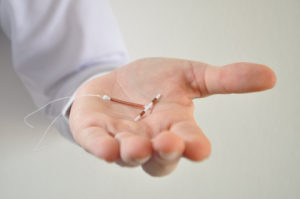Back to Contraception List
An IUD is a small, “T-shaped” contraceptive device which is placed in a woman’s uterus. It is also known as the loop, the coil or copper coil. IUDs are made of flexible plastic with a coating of thin copper wire. It has one or two soft threads on the end. These thin threads hang through the opening at the entrance of the womb (cervix) into the top of the vagina. If used properly, they are 98-99% effective. It stops sperm from meeting the egg as it delays the egg getting into the womb.
An IUD works as soon as it’s put in, and lasts for five to 10 years, depending on the type. It can be put in at any time during your menstrual cycle, as long as you’re not pregnant. It can be removed at any time by a specially trained doctor or nurse and you’ll quickly return to normal levels of fertility. If you get pregnant, there’s an increased risk of ectopic pregnancy (when the egg implants outside the womb). But because you’re unlikely to get pregnant, the overall risk of ectopic pregnancy is lower than in women who don’t use contraception.
Benefits of choosing the Coil
- Changes in your period- many become lighter
- Can be used if breastfeeding

- Does not interrupt sex
- It is effective immediately after its fitted
- The coil can stay in your womb for approximately 5-10 years
- It is not effected by vomiting, diarrhoea or by other medicines
Disadvantages of choosing the Coil
- You might get spotting or bleeding between periods
- There’s a very small chance of infection within 20 days of the IUD being fitted
- There’s a risk that your body may expel the IUD (NHS, 2017)
- Changes to your periods – longer or more painful
- Using the coil can lead to heavy periods for some women
- The insertion and removal must be done by a doctor who is trained in this procedure
- The coil doesn’t protect against STIs (HSE, 2016)
For more information on the coil, click on any of the following links;